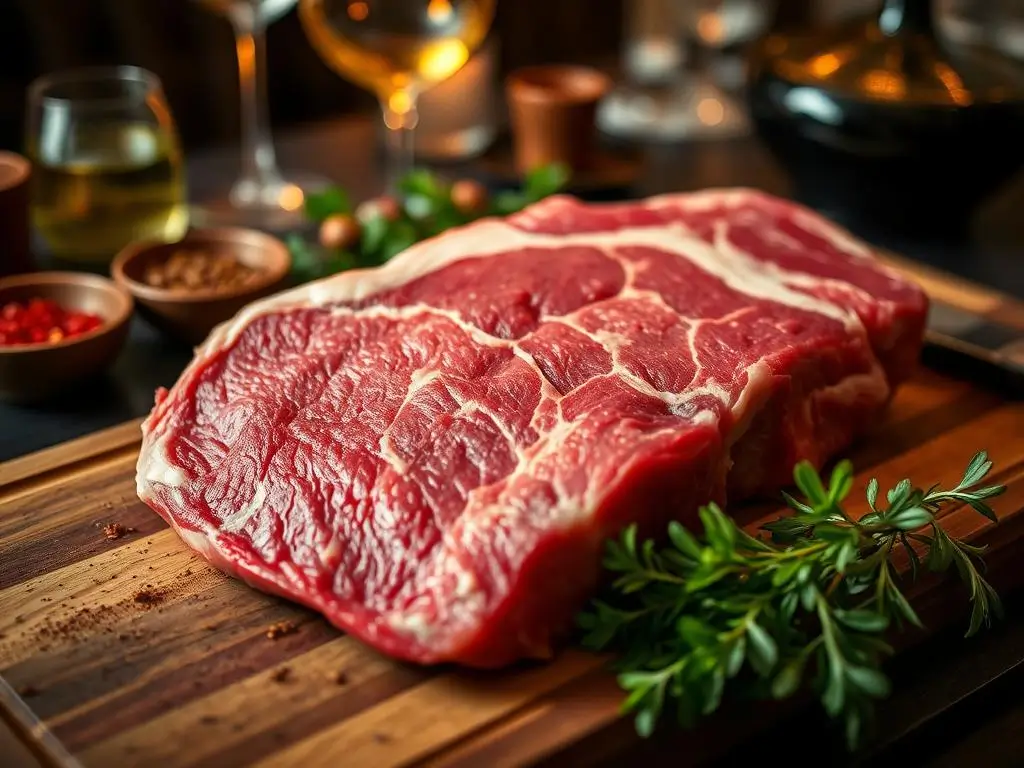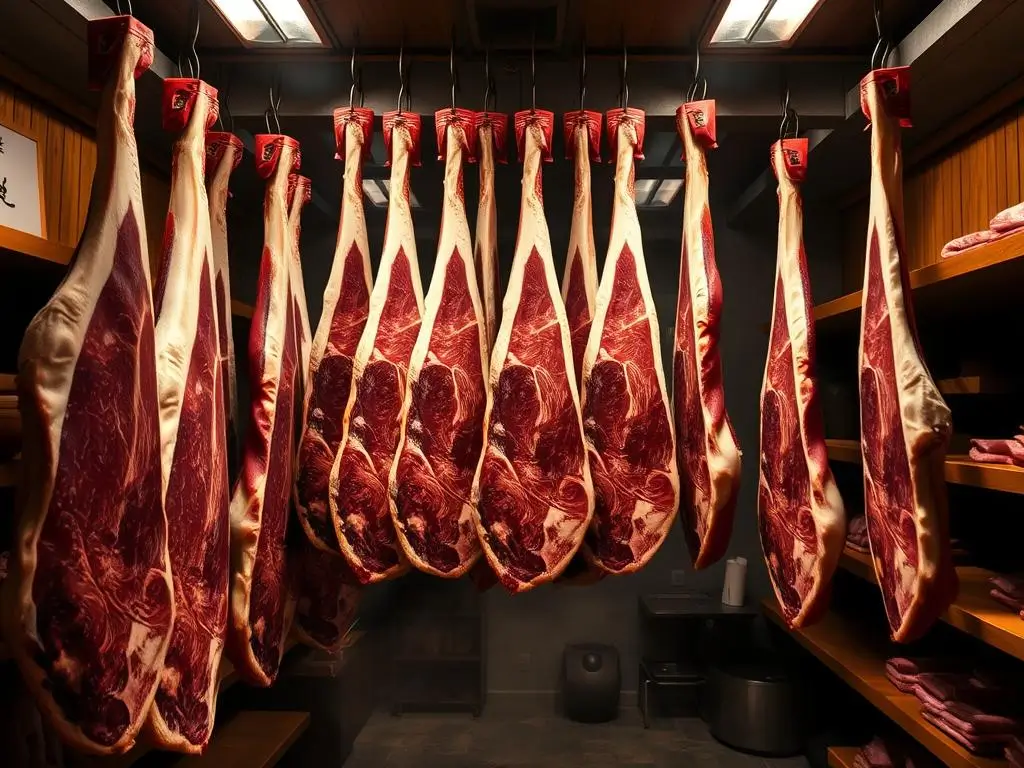Have you ever wondered why some types of meat come with such a hefty price tag? What is the most expensive Asian meat? Japanese Wagyu is considered the most expensive, renowned for its exquisite marbling and unmatched tenderness, with prices ranging from $50 to $250 per pound. But what makes it so extraordinary, and why are people willing to pay a premium for it?
The secret lies in the extraordinary care given to Wagyu cattle throughout their lives. These animals are raised in stress-free environments, with some even receiving massages or beer to ensure their comfort and well-being. Their diet, rich in high-quality grains, rice bran, and soybean meal, plays a significant role in enhancing the flavor and texture of the meat. What is the most expensive Asian meat? The answer is undoubtedly Japanese Wagyu, celebrated for its luxurious quality and meticulous production process.
Kobe and Matsusaka are two top Wagyu types. Kobe comes from Hyogo Prefecture and is famous for its marbling and softness. Matsusaka, from Mie Prefecture, is known for its delicate taste and tenderness.
What makes Wagyu so rare and expensive? Japan’s Wagyu farms are small, with only 10 to 100 animals. This limited supply and high demand push prices up. In the US, import taxes add to the cost, making Wagyu a luxury item.
Table of contents
- Key Takeaways
- What Makes Meat Expensive?
- Understanding Wagyu Beef
- What Is Kobe Beef?
- What Is Matsusaka Beef?
- The Feeding Practices Behind Wagyu Beef
- The Aging Process of Wagyu
- Geographic Impact on Meat Quality
- The Role of Marbling in Wagyu
- Health Benefits of Wagyu Beef
- Where to Buy Expensive Wagyu
- Conclusion: The Experience of Luxury Meat
- FAQ
Key Takeaways
- Wagyu beef is a high-quality, luxury Japanese beef renowned for its exceptional marbling and tenderness.
- Prices for Wagyu beef can range from $50 to $250 per pound, depending on the cut and quality.
- Kobe and Matsusaka are two of the most famous and sought-after varieties of Wagyu beef.
- Wagyu cattle are raised in stress-free environments with individualized care and unique feeding regimens.
- The limited supply and high demand for Wagyu beef, as well as import taxes, contribute to its high cost.
What Makes Meat Expensive?
The world of luxury foods, culinary delights, and gastronomic indulgences often revolves around the price tag. Japanese Wagyu beef is at the top, with prices that can make your wallet cringe. But what makes this beef so costly?
Factors Influencing Meat Prices
The high price of Wagyu beef comes from several factors. First, Japan’s limited land means Wagyu cattle are raised in small feedlots. Each farm has only 10 to 100 animals. This scarcity makes Wagyu meat exclusive and pricey.
Wagyu cattle also get special high-energy diets, with imported feed and ingredients. This adds to the production costs. Wagyu is cared for extensively, often for over 600 days. This is much longer than domestic farms, which raises the price.
Comparisons to Other Meat Types
Wagyu’s pricing is unique when compared to other premium meats. A patty of A5 Japanese Wagyu beef, used in the Golden Boy burger, can cost $50 to $200 per pound. USDA Prime beef, the top choice in the U.S., costs $20 to $40 per pound.
Wagyu beef’s high costs, like import duties and quotas in the U.S., add to its exclusivity. These factors make Wagyu one of the most luxurious and coveted culinary delights in the world of gastronomic indulgences.
Understanding Wagyu Beef
Wagyu, which translates to “Japanese cow,” represents four prestigious cattle breeds originating from Japan: Japanese Black, Japanese Brown, Japanese Shorthorn, and Japanese Polled. Among these, the Japanese Black breed stands out, contributing to 90% of all Wagyu and earning fame for producing the renowned Kobe beef. Each breed has unique characteristics, yet all adhere to the rigorous standards that define the premium quality of Wagyu beef. What is the most expensive Asian meat? It’s undoubtedly Wagyu, celebrated globally for its unparalleled flavor and meticulous production methods.
The Origins of Wagyu
The history of Wagyu beef goes back centuries. Selective breeding has made these cattle special. They are naturally good at marbling, which makes their meat rich and soft.
This natural talent, along with careful care and feeding, makes Wagyu beef stand out. It’s a top choice among rare proteins and Asian delicacies.
Different Types of Wagyu
- Japanese Black: The most famous Wagyu breed, known for its great marbling and taste.
- Japanese Brown: Also known as Akaushi, this breed is loved for its tenderness and unique taste.
- Japanese Shorthorn: A lighter, leaner breed with a special flavor, often used in certain dishes.
- Japanese Polled: A hornless Wagyu, valued for its easy handling and gentler nature.
Explore more about exotic and rare proteins in our Luxury Meats Guide.
What Is Kobe Beef?
Kobe beef is a rare and exclusive exotic meat from Japan. It comes from the Tajima strain of Japanese Black cattle in Hyogo Prefecture. This luxury food is known for its amazing marbling, tenderness, and rich, buttery taste.
Unique Characteristics of Kobe Beef
To be real Kobe beef, the cattle must meet strict rules. They must be born, raised, and processed in Hyogo Prefecture. This ensures the unique taste and quality of Kobe beef.
Also, the cattle must be purebred Tajima lineage. They should weigh no more than 470 kilograms.
The Importance of Certification
Because Kobe beef is so rare and exclusive, it’s vital to check its authenticity. Only a small part of Wagyu cattle qualify as Kobe beef. This makes it one of the most expensive exotic meats globally.

For more information on authentic meat sourcing, visit our Sustainable Meat Guide.
Kobe beef stands out with its unmatched marbling, tenderness, and flavor, making it a symbol of exceptional quality. Its strict production and geographic rules ensure authenticity and maintain the highest standards of excellence. What is the most expensive Asian meat? Kobe beef undoubtedly earns its place as a true culinary luxury food that delights the senses and exemplifies the finest in premium beef.
What Is Matsusaka Beef?
Matsusaka beef is a rare and delicious gem in the world of food. It comes from the Mie Prefecture in Japan. This wagyu beef is as good as Kobe beef, with unmatched quality and taste.
Flavor Profile of Matsusaka Beef
Matsusaka beef is famous for its rich, buttery taste. It has a lot of fat, making it tender and juicy. The cows are raised carefully, giving the meat a unique flavor.
The Rarity of Matsusaka Beef
Matsusaka beef is rare and expensive because of its limited supply. It’s raised in a special area with a controlled diet. This makes it a luxury item for food lovers.
For a taste of Matsusaka beef, visit restaurants in Mie Prefecture or Tokyo. It’s perfect as a steak or in shabu-shabu. Matsusaka beef celebrates Japanese cuisine at its finest.
The Feeding Practices Behind Wagyu Beef
To achieve Wagyu beef’s renowned taste and marbling, a meticulously crafted feeding regimen is essential. Wagyu cattle are fed a diet rich in energy, including rice bran, beer yeast, soybean meal, wheat, and rice straw. Farmers carefully adjust this diet as the cattle grow, ensuring they develop to their highest quality. What is the most expensive Asian meat? Wagyu beef undoubtedly holds this title, thanks to the extraordinary care and dedication involved in its production.
Traditional vs. Modern Feeding Techniques
In Japan, feeding wagyu cattle has been done the same way for many years. But, some farmers today use new methods to make wagyu even better. For example, some feed beer to make the cattle hungrier. Others play music to keep them calm and happy.
The Role of Grain and Fat
The long feeding time, often 30 to 36 months, and a high-quality diet are key. This diet, rich in grain and fat, makes wagyu beef special. It’s why wagyu is loved for its tender taste, a favorite among those who enjoy Asian delicacies.
| Feeding Practices | Traditional | Modern |
|---|---|---|
| Diet Composition | Rice bran, soybean meal, wheat, rice straw | Inclusion of beer, music to reduce stress |
| Feeding Period | 30-36 months | Varies based on individual farm practices |
| Emphasis | Balanced grain and fat intake | Enhancing marbling and flavor |
Learn about other artisanal farming methods in our Artisan Meats Guide.
The Aging Process of Wagyu
The aging process is key for exotic meats like Wagyu beef. It’s known for its amazing marbling and tenderness. This makes it a top choice for food lovers.
Wet Aging vs. Dry Aging
Wagyu beef is aged in two ways: wet and dry. Wet aging seals the meat to keep it moist. Dry aging lets it breathe in a special environment. Both methods make the meat tender and flavorful.
How Aging Affects Flavor and Price
Aging Wagyu can take weeks or even months. This time changes its texture and taste. It also raises the cost, making Wagyu a luxury exotic meat.
The longer it ages, the more complex its flavor becomes. This makes Wagyu a unique exotic meat experience.
| Aging Method | Time Frame | Impact on Flavor and Texture |
|---|---|---|
| Wet Aging | 2-4 weeks | Increased tenderness, mild flavor enhancement |
| Dry Aging | 4-8 weeks | Intensified umami notes, more pronounced beefy flavor, tenderization |

The aging process is vital for Wagyu. It turns this exotic meat into a culinary delight. Producers control moisture, temperature, and time to create a perfect taste experience.
Geographic Impact on Meat Quality
Certain regions in Japan are renowned for producing exceptional Wagyu beef. Hyogo Prefecture is celebrated for Kobe beef, Mie Prefecture for Matsusaka beef, and Shiga Prefecture for Omi beef. Each variety offers a unique taste and quality, shaped by the local environment. What is the most expensive Asian meat? Wagyu beef from these regions undoubtedly stands out, known for its unparalleled flavor and meticulous production standards.
Regions Known for High-Quality Beef
- Hyogo Prefecture (Kobe): The mild climate, clean water, and nutrient-rich soil here make Kobe beef tender and marbled.
- Mie Prefecture (Matsusaka): The prefecture’s temperate climate and lush grazing lands give Matsusaka beef its sweet and buttery taste.
- Shiga Prefecture (Omi): The cool, mountainous climate and pure water sources make Omi beef rich in umami flavor.
Climate and Its Influence on Flavor
The climate, soil, and water in these famous beef areas greatly affect the cattle’s diet and living. This, in turn, shapes the unique flavors of Kobe, Matsusaka, and Omi beef. These most expensive Asian meats are highly prized luxury foods globally.
The Role of Marbling in Wagyu
Wagyu beef is known for its unique taste and texture, thanks to marbling. Marbling is the fat that’s spread out in the meat. It makes Wagyu beef look special and feel like it melts in your mouth.
Understanding Marbling Scores
The Japan Beef Marbling Standard (BMS) rates Wagyu beef from 1 to 12. A score of 12 is the highest. Wagyu beef like A5 Wagyu usually scores between 8 and 12. This means it has lots of fine, white fat in the meat.
How Marbling Affects Taste
- Wagyu beef’s marbling makes it tender, juicy, and full of flavor. It’s unlike any other beef.
- Beef with Marble Scores of 7 and 8 is very rich and tender. It’s often saved for special meals.
- Wagyu beef with scores of 9+ is the rarest. It’s found in less than 1% of Wagyu cows. It’s the ultimate luxury with its perfectly marbled meat.
The special marbling of Wagyu beef shows the care Japanese farmers put into raising their cattle. It offers a dining experience that’s both rare and pricey.
Health Benefits of Wagyu Beef
Wagyu beef isn’t just about its luxurious fat content; it also offers significant health benefits. It contains higher levels of monounsaturated fats, such as oleic acid, compared to other types of beef. Additionally, it is rich in omega-3 and omega-6 fatty acids, as well as conjugated linoleic acid (CLA), which is believed to have cancer-fighting properties. What is the most expensive Asian meat? Wagyu beef takes this title, offering not only exceptional taste but also surprising nutritional advantages.
Nutritional Value
Wagyu beef is not just tasty; it’s also full of nutrients. It’s a top source of protein, essential for muscle repair. It also has more vitamins and minerals like iron, vitamin B12, and zinc than regular beef.
Comparisons to Other Meat Types
- Wagyu beef has a better omega-3 to omega-6 fatty acid ratio, which is good for the heart.
- Research shows Wagyu beef has lower total cholesterol than other beef, making it a healthier choice.
- The fine marbling in Wagyu beef makes its nutrients more available, improving how well they’re absorbed.
- Studies suggest Wagyu beef’s omega-3 fatty acids might boost mental health.
While Wagyu beef is nutritious and delicious, it should be eaten in small amounts. It’s high in calories and fat. Cooking methods like grilling or broiling can also help reduce fat.
| Nutrient | Wagyu Beef | Conventional Beef |
|---|---|---|
| Monounsaturated Fats | Higher | Lower |
| Omega-3 Fatty Acids | Higher | Lower |
| Conjugated Linoleic Acid (CLA) | Higher | Lower |
| Total Cholesterol | Lower | Higher |
| Protein Content | Similar | Similar |
Where to Buy Expensive Wagyu
For those who love wagyu, finding the right place to buy is key. Japanese wagyu, like Kobe beef, is a luxury. It’s known for its marbling and flavor. Luckily, there are places online and in stores for those who want the best.
For tips on purchasing quality meats, visit our Meat Buying Guide.
Discovering Authentic Wagyu Retailers
In the U.S., high-end butcher shops and specialty meat markets are the places to go. DeBragga, Holy Grail Steak Co., and Crowd Cow have deals with top wagyu farms. They offer many wagyu types and help you find the real deal.
Exploring Online Wagyu Purchasing Options
- Rastelli’s sources American wagyu from Japanese bloodlines.
- Snake River Farms mixes Japanese genetics with American beef.
- Holy Grail Steak Co. and Crowd Cow have many wagyu options, including luxury meats.
When buying wagyu, look for certifications and know where it comes from. This way, you can enjoy the best of this Asian meat. With the right knowledge, your meals can be truly special.
Conclusion: The Experience of Luxury Meat
Wagyu beef is a one-of-a-kind delight for the taste buds, including renowned varieties like Kobe and Matsusaka. These exceptional meats provide a unique culinary experience that truly awakens the senses.
What is the most expensive Asian meat? Wagyu beef undeniably earns this title, offering unmatched flavor, tenderness, and even health benefits. While its high price might seem intimidating, Wagyu is well worth it for creating unforgettable, special moments.
For more insights into premium meats, explore our Luxury Meat Guide or Exotic Meat Recipes for inspiration.
How to Enjoy Wagyu at Home
To enjoy Wagyu, keep things simple. Just use salt and pepper to let its natural taste shine. In dishes like shabu-shabu and sukiyaki, Wagyu is cooked briefly.
This makes it melt in your mouth. Because of its rich taste, Wagyu is served in small amounts. This way, every bite is a delight.
The Cost of Indulgence
The price of Wagyu shows the hard work and care in raising these cattle. The special diets and longer growth periods add to the cost. But, for many, Wagyu’s taste and texture are worth it.
It turns a meal into a memorable experience. It’s a treat that makes every bite special.
FAQ
What is the most expensive Asian beef?
The most expensive Asian beef is A5-grade Japanese Wagyu, particularly Kobe beef. Known for its incredible marbling, tenderness, and flavor, A5 Wagyu commands a premium price due to its meticulous breeding, feeding process, and strict quality standards.
Is Kobe or wagyu more expensive?
Kobe beef is a type of Wagyu, but not all Wagyu is Kobe. Kobe beef is typically more expensive than other types of Wagyu because it comes from specific Tajima cattle raised in the Hyogo Prefecture under strict conditions. The exclusivity and certification process for Kobe beef elevate its price above other Wagyu varieties.
Which is the most expensive meat?
The most expensive meat in the world is often A5-grade Japanese Kobe beef. Among other contenders, Matsusaka beef and Olive-fed Wagyu from Japan can also reach staggering prices. These premium meats are highly sought after for their exceptional quality and limited availability.
Why is A5 wagyu beef so expensive?
A5 Wagyu beef is expensive because of its high-quality marbling, which gives it unmatched tenderness and flavor. The cattle are raised with exceptional care, including specialized diets and stress-free environments. Additionally, the grading system for Wagyu ensures only the best beef receives the A5 designation, making it rare and highly desirable.

